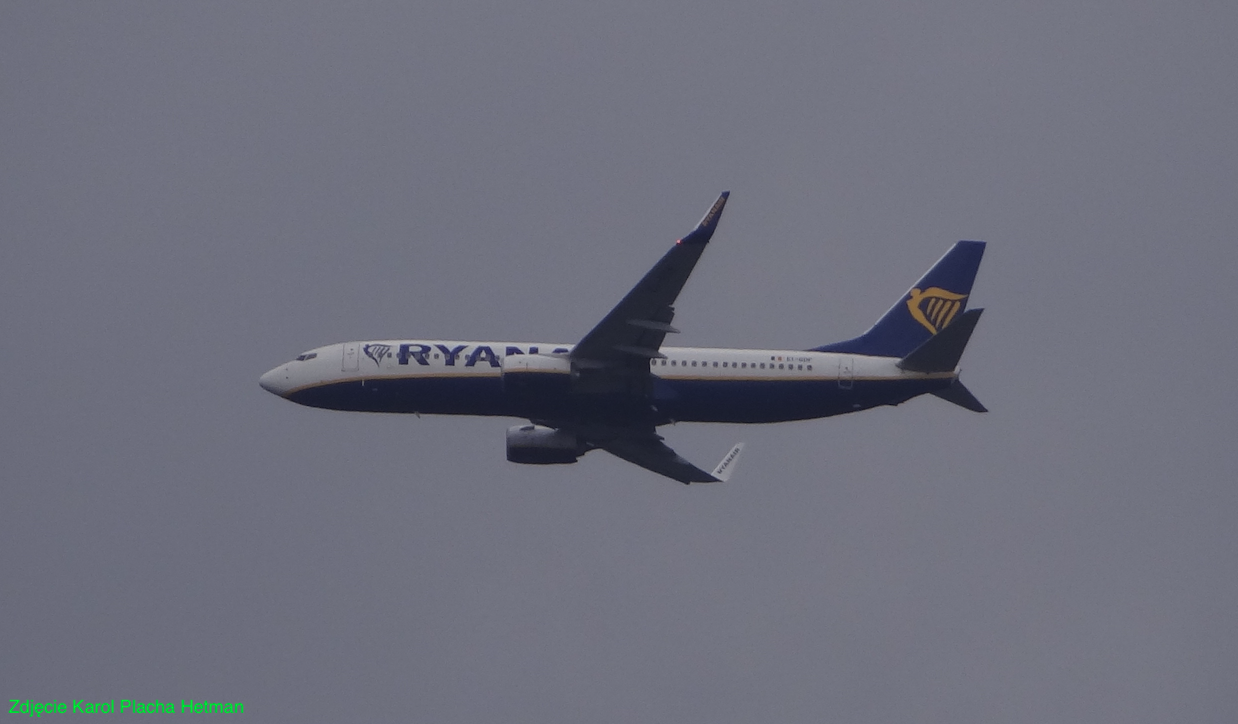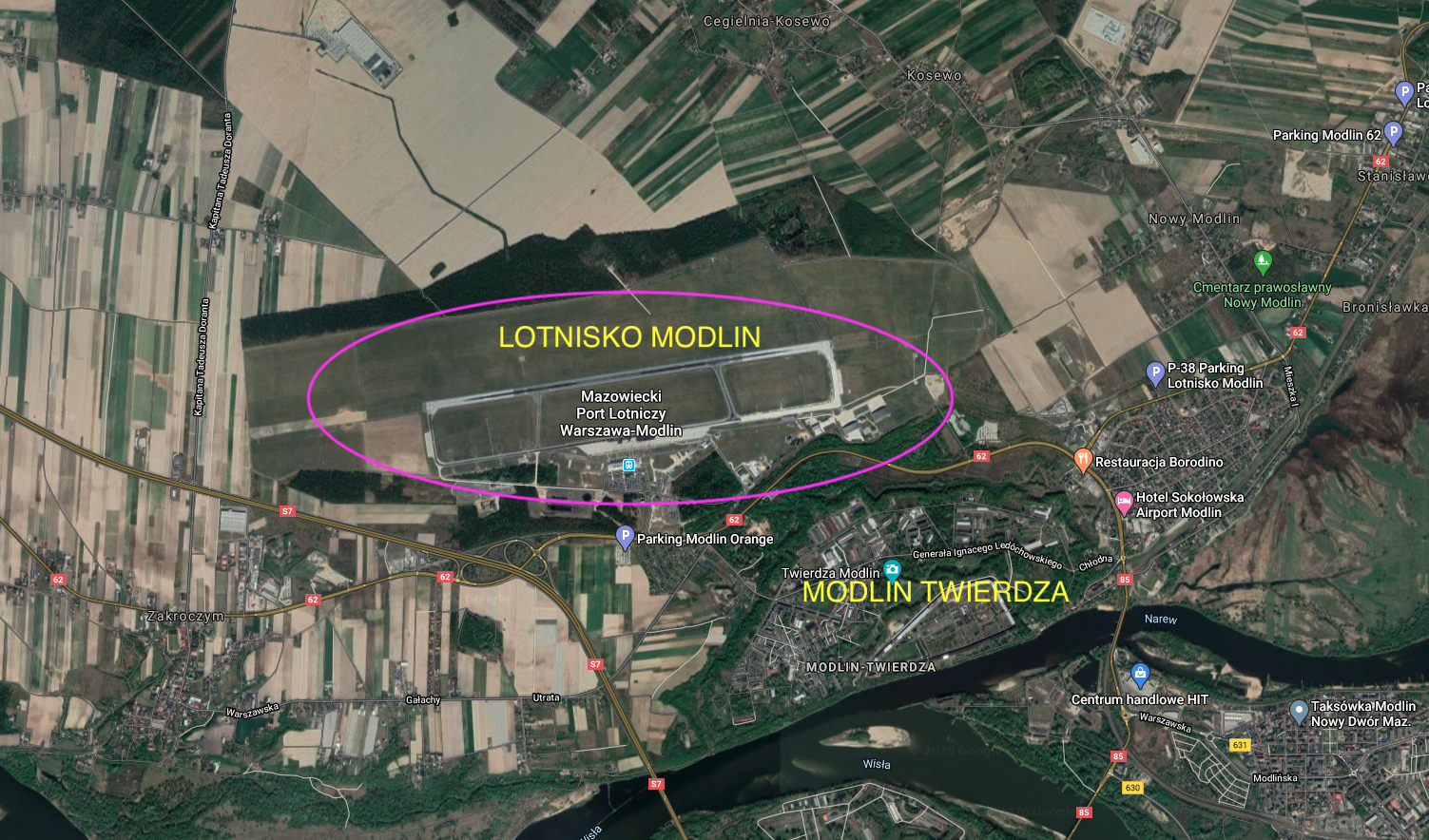Modlin 2011-05-30
Modlin Lotnisko.
Współrzędne geograficzne: 52.451N 20.651E.
Centralny Port Lotniczy (Narodowy Port Lotniczy) w Modlinie.
W 2003 roku, z uwagi na wyczerpanie się możliwości przewozowych największego w Polsce cywilnego portu lotniczego Okęcie, odżyły plany budowy nowego Centralnego Portu Lotniczego zwanego czasami Narodowym Portem Lotniczym. Wstępne prace wykonali analitycy, którzy określili, że Polski CPL (Centralny Port Lotniczy) powinien zajmować powierzchnię 1 300 hektarów. Na około lotniska ma zostać utworzona strefa ograniczonego użytkowania o powierzchni 6 000 hektarów. Przyszłe lotnisko zostanie wyposażone w dwie DS (RWY), każda o wymiarach 4 000 m x 60 m, położonych równolegle do siebie i oddalone od siebie o 2 000 m. Lotnisko miało być wykonane w I klasie. Okęcie ma (2009 roku) III klasę. Nowe lotnisko będzie obsługiwało początkowo 10-20 milionów pasażerów, by z końcem ostatniego etapu budowy obsłużyć 60-70 mln pasażerów rocznie i będzie odprawiało 400 000 ton ładunków rocznie. (Okęcie obsługuje 6 mln pasażerów i ma 200 000 ton ładunków). Nowe lotnisko będzie wykonywać w tym czasie 500 tysięcy operacji startów i lądowań rocznie, czyli 56 operacji w ciągu godziny. Port lotniczy ma być umieszczony pomiędzy DS (RWY). Dojazd ma zapewniać system komunikacji podziemnej. Również podziemny ma byś system; przesyłu bagażu, cateringu, tankowania samolotów. Dotarcie pasażerów do/z samolotu mają zapewniać rękawy. Port ma obsłużyć największe samoloty świata. Budowa ogromnego terminalu będzie oparta o koncepcję budynków sekcji, które będą przyrastać w miarę wzrostu liczny odprawianych pasażerów. Koszt takiej inwestycji to miało być 2 miliardy euro.
W 2004 roku, Modlin, na równi z Mszczonowem, został wybrany z siedmiu proponowanych lokalizacji. O ile lotnisko w Modlinie istnieje i jest czynne, to w Mszczonowie żadnego lotniska nie ma. Wybory te były bardzo emocjonalne i nie wszyscy je zaakceptowali. Okazało się, że budowa takiego lotniska w Modlinie może za sobą pociągnąć konieczność wysiedlenia około tysiąca rodzin, z okolic projektowanego portu. W pierwszej kolejności wysiedleni byliby prawdopodobnie mieszkańcy Wójtostwa, po zachodniej stronie lotniska, a także Cegielni-Kosewa po stronie północno-wschodniej.
Zarówno w przypadku Modlina, jak i Mszczonowa, trzeba będzie dokupić sporo gruntów. Tym miałby się zająć Rząd Rzeczypospolitej. Przygotowywany już jest projekt specjalnej ustawy w tej sprawie, który będzie dopuszczał możliwość wywłaszczenia najbardziej opornych (?) właścicieli.
Ministerstwo Infrastruktury postawiło wymóg dojazdu do lotniska lub Warszawy wynoszący około 15 minut. Aby spełnić te wymogi, trzeba zwiększyć przepustowość dróg biegnących w kierunku Stolicy dla transportu kołowego, usprawnić regionalną komunikację kolejową, a nawet stworzyć nowe szybkie szlaki komunikacyjne. Szczególnym atutem jest metro warszawskie, które jest potencjalnie najszybszą, bezkolizyjną metodą przemieszczania się pasażerów na nowe lotnisko. Żeby wykorzystać zalety metra, jako nowoczesnego i wydajnego systemu transportu zbiorowego, trzeba stworzyć Północną Linię łączącą Warszawę z Narodowym Portem Lotniczym. Dla transportu kołowego to stworzenie trasy Legionowo – Nowy Dwór poprzez modernizację odcinka drogi. Dodany zostanie nowy północny odcinek trasy skierowany do terminalu, prawdopodobnie wpuszczony w tunel pod Narwią.
Pod budowę lotniska w Mszczonowie przeznaczono 880 ha terenu, jest to powierzchnia o 1/3 mniejsza niż w Modlinie (1 300 hektarów). Zaletą (a według innych wadą) Mszczonowskiej lokalizacji jest brak lotniska do rozbiórki, co ułatwia budowę lotniska międzykontynentalnego. Jednak mniejszy obszar przeznaczony pod lotnisko wymusi inny, bardziej zwarty, lecz niewiele mniej wydajny układ pasów startowych oraz terminali. Mszczonów to najwyżej położone miasto na całej Nizinie Mazowieckiej. Tym samym tu rzadziej, niż u sąsiadów, występują zamglenia i opady. Mszczonów leży obok ważnych szlaków komunikacyjnych – planowanej autostrady A2, przepełnionej E8 (Trasy Katowickiej), oraz ważnych szlaków kolejowych. Ponadto Mszczonów jest preferowaną przez Unię Europejską lokalizacją dla międzykontynentalnego lotniska. Oznacza to łatwiejsze skorzystanie z większej ilości funduszów unijnych, ale także kolejne uzależnienie Rzeczypospolitej Polski od hybrydy jakim jest Unia Europejska. Reasumując obcy kapitał w Polsce wybudowałaby sobie z Mszczonowie Lotnisko, z którego zyski odpływałyby na Zachód.
Jednak centralne plany legły w gruzach. Przynajmniej na jakiś czas. Dlatego samorządy takich Gmin jak Nowy Dwór Mazowiecki i Sochaczew dostrzegły swoją szansę w otwarciu Regionalnych Portów Lotniczych, dla tanich linii lotniczych.
Mazowiecki Port Lotniczy. 2003 rok.
W listopadzie 2003 roku, podpisano w siedzibie Regionalnego Centrum Doradztwa, Rozwoju Rolnictwa i Obszarów Wiejskich „Poświętne" listu intencyjnego przez parlamentarzystów, samorządowców, biznesmenów na rzecz lokalizacji portu lotniczego na terenie byłego lotniska wojskowego w Modlinie.
W kwietniu 2005 roku, podpisano Akt Założycielski Spółki Port Lotniczy Modlin Sp. z o.o. (Akt Notarialny sporządzony dnia 22 kwietnia 2005 roku), w maju 2005 roku, przedstawiono wstępny Biznes Plan dla projektu uruchomienia i eksploatacji lotniska w Modlinie. Już w lipcu 2005 roku, zawarto umowę pomiędzy Przedsiębiorstwem Państwowym „Porty Lotnicze”, a Agencją Mienia Wojskowego, na podstawie której: Przedsiębiorstwo Państwowe „Porty Lotnicze" zakupiło część udziałów w gruncie, na którym realizowany będzie projekt lotniska. Agencja Mienia Wojskowego i Przedsiębiorstwo Państwowe „Porty Lotnicze" przekazały spółce Port Lotniczy Modlin prawa do zarządzania lotniskiem w Modlinie. Przedsiębiorstwo Państwowe „Porty Lotnicze" zobowiązało się do wykonania modernizacji lotniska, a w zamian Agencja Mienia Wojskowego zobowiązała się przekazać dalsze udziały w gruncie.
W dniu 26 października 2006 roku, Urząd Lotnictwa Cywilnego (ULC) wydał promesę, na założenie lotniska cywilnego użytku publicznego w Modlinie, a w dniu 8 listopada 2006 roku, zawarto porozumienie pomiędzy Agencją Mienia Wojskowego, Przedsiębiorstwem Państwowym „Porty Lotnicze", Samorządem Województwa Mazowieckiego oraz Gminą Nowy Dwór Mazowiecki w kwestii zawiązania Spółki Mazowiecki Port Lotniczy Warszawa-Modlin, która będzie kontynuowała inwestycje dotyczące lotniska. Po około 1/3 jej udziałów mają: Agencja Mienia Wojskowego (w zamian za przekazanie spółce na własność grunty pod port, w sumie 292 hektary), Przedsiębiorstwo Państwowe "Porty Lotnicze" i samorząd Województwa Mazowieckiego, który sfinansuje część inwestycji, przekazując spółce 16 mln zł w 2006 roku, 30 mln w 2007 roku, i 50 mln w 2008 roku. Gmina Nowy Dwór posiada 5% udziałów spółki. W tym czasie koszt inwestycji szacowano na 200-300 milionów złotych.
W grudniu 2006 roku, podpisano znowelizowaną Umowę Spółki, w wyniku której nastąpiła: Zmiana nazwy Spółki Port Lotniczy Modlin na Mazowiecki Port Lotniczy Warszawa-Modlin Sp. z o.o., zmiana struktury właścicielskiej – obecnie udziałowcami Spółki są: Województwo Mazowieckie, Przedsiębiorstwo Państwowe „Porty Lotnicze", Agencja Mienia Wojskowego, Miasto Nowy Dwór Mazowiecki.
Z początkiem 2007 roku, do ataku przystąpili tak zwani ekolodzy. Tu pragniemy zauważyć, że Ekologia to nie to samo co Ochrona Przyrody i Ochrona Środowiska. I po raz kolejny w Rzeczypospolitej Polsce ujawniły się siły, za którymi stoi obcy kapitał. I po raz kolejny prym w podsycaniu napięcia wiodły polskojęzyczne masońskie media. Tym razem, pseudo ochroniarzom przyrody, na sumieniu był los ptaków. Twierdzili, że rozbudowa lotniska ograniczy liczbę ptaków w okolicy. Że zaistnieje większe niż na innych lotniskach ryzyko kolizji ptaków z samolotami. A to było bardzo ciekawe. Bo od 1936 roku, kiedy istnieje lotnisko, to chyba 70-te pokolenie ptaków przyzwyczaiło się do szumu samolotów. Na szczęście nie udało się zablokować działań Spółki, choć 12 miesięcy zostało straconych. Powstał poprawiony Raport Środowiskowy. Burmistrz Nowego Dworu Mazowieckiego, Jacek Kowalski wydał w marcu 2009 roku, decyzję środowiskową dla lotniska Modlin. Umożliwi ona dalsze prace inwestycyjne, tak aby lotnisko było gotowe do 2012 roku. W wyniku kompleksowych badań przyrodniczych powstały zalecenia zmierzające do zminimalizowania wpływu inwestycji na środowisko. Decyzja środowiskowa to zgoda na realizację inwestycji, która w znaczącym stopniu może oddziaływać na środowisko naturalne.
Udziałowcami Spółki Mazowiecki Port Lotniczy Warszawa – Modlin są Agencja Mienia Wojskowego – 40,01 proc., Województwo Mazowieckie – 30,60 proc., Przedsiębiorstwo Państwowe "Porty Lotnicze" – 26,17 proc. oraz Miasto Nowy Dwór Mazowiecki – 3,22 proc. Adres: Mazowiecki Port Lotniczy Warszawa-Modlin Sp. Zoo ulica generała Wiktora Thommee 1 A 05-102 Nowy Dwór Mazowiecki.
Jak ma wyglądać nowe lotnisko? 2009 rok.
Wg biznes-planu udostępnionego w styczniu 2007 roku, przewidywano dwa terminale pasażerskie, terminal cargo, ogrodzenie lotniska, oświetlenie nawigacyjne lotniska, system ILS, modernizację DK, remont i wydłużenie DS (RWY) do 2 800 m, z jednoczesnym zwężeniem do 60 m, modernizacja i poszerzenie płyty postoju samolotów, budowa dwóch dróg szybkiego zjazdu z DS, parkingi i podjazdy do terminali. Dodatkowy pas startowy o nawierzchni trawiastej będzie miał wymiary 2 620 m x 300 m.
W marcu 2009 roku, ukończono nowe ogrodzenie lotnika, którego budowę rozpoczęto w 2008 roku. Droga startowa wymagała badań, aby stwierdzić konieczny zakres jej remontu-modernizacji.
Na terenie lotniska zaplanowano miejsce na stację kolejową. Ma ona połączyć lotnisko z Warszawą i Okęciem. W ramach tego projektu niezbędne będzie w Modlinie położenie 5,5 km nowych torów, modernizacja bocznicy kolejowej, budowa peronów oraz wiaduktu nad drogą krajową Nr 62. Koszty związane z tymi inwestycjami pokryje samorząd województwa mazowieckiego. W budżecie województwa zarezerwowano na ten cel 60 mln zł. Samorząd nie wyklucza również ubiegania się o środki unijne na ten cel. Przejazd między obydwoma portami ma trwać 45-50 minut.
Koszt inwestycji to ok. 305 – 400 mln zł. Unia Europejska przyznała dofinansowanie w wysokości 76,2 mln zł. Planowana przepustowość lotniska to około 1 500 000 pasażerów roczne.
Droga startowa wyposażona zostanie w system świateł podejścia I kategorii oraz światła krawędziowe i progowe, a także oznakowanie poziome i pionowe.
Drogi kołowania (DK). W etapie początkowym przewiduje się wykorzystanie dwóch odcinków dróg kołowania poprzecznych DK-B i DK-D oraz łączącej ich drogi równoległej wzdłuż płyty PPS-1. Dopuszcza się kołowanie samolotów po drodze startowej tzw. back-track. Drogi kołowania wymagają poszerzenia do szerokości normatywnych 23+2 x 7,5 m. Zostaną one wyposażone w oświetlenie krawędziowe.
Płyta (płaszczyzna, płyta peronowa) postoju samolotów (PPS). Płyta pozostanie w obecnym kształcie, zostanie przeprowadzony remont nawierzchni. Samoloty będą ustawiane w systemie „na własnym ciągu" umożliwiając pasażerom piesze dojście do samolotu. W dalszym rozwoju lotniska możliwy będzie do zastosowania system „push-back". Płyta zostanie odpowiednio oznakowana i oświetlona projektorami.
Pomoce nawigacyjne. Planuje się wyposażenie lotniska w NDB, DVOR/DME, ILS. Zostanie również zainstalowany pełny system świateł podejścia. Droga startowa na obydwu kierunkach wyposażona zostanie w wizualny wskaźnik ścieżki schodzenia PAPI. Na lotnisku zostanie zainstalowana wieża mobilna, której zadaniem będzie kontrola zbliżenia oraz kontrola płyty lotniska. Przy wieży zainstalowany zostanie system Meteo.
Terminal. Podstawowym obiektem kubaturowym na lotnisku będzie terminal pasażerski o konstrukcji stalowej i powierzchni zabudowy około 7 500 m2, z częścią na antresoli o powierzchni ok. 2 000 m2. Odloty i przyloty zlokalizowane będą na tym samym poziomie.
Parkingi. Na terenie lotniska zaplanowano początkowo działanie trzech parkingów na łącznie 877 miejsc postojowych. W związku z prognozowanym wzrostem liczby pasażerów w dalszej przyszłości dokonana będzie rozbudowa parkingów (do ok. 1 300 miejsc).
Hangary. Na terenie lotniska znajdują się trzy hangary. Mały hangar przeznaczono na potrzeby lotniskowej straży pożarnej. Duży hangar nr 1 zaplanowano na potrzeby służb technicznych i utrzymania lotniska, natomiast duży hangar nr 2 przewidziany jest do obsługi technicznej samolotów. Obiekty te wymagają znacznych prac modernizacyjnych.
Inne obiekty istniejące. Domek pilotów, zarząd portu, kotłownia i dwie stacje trafo przeznaczono dla odpowiednich, przewidzianych programem funkcji. Obiekty te zostaną gruntownie przebudowane. MPS ( magazyn materiałów pędnych i smarów ). Dla potrzeb lotniska cywilnego przewiduje się wykorzystanie MPS-1. Ze względu na czas i koszty modernizacji, w początkowym etapie planuje się tankowanie samolotów bezpośrednio z autocystern.
Cargo. W dalszej przyszłości planowana jest budowa Terminala Cargo o przepustowości 15 000 ton rocznie.
Dane Lotniska obecnie. 2009 rok.
Lotnisko określane jest jako Międzynarodowy Port Lotniczy Warszawa-Modlin. Posiada kod ICAO – EPMO. Jedna DS o wymiarach 2 500 m x 60 (80) m, na kierunku 08/26 z nawierzchnią asfalto-betonową.
Lotnisko ma powierzchnię 579,16 hektarów. Na terenie znajduje się 49 budynków o łącznej powierzchni użytkowej 17 973 m2. Dwa składy paliw mają zbiorniki o łącznej pojemności 2 100 m3. Na lotnisku znajdują się 3 hangary, o łącznej powierzchni użytkowej 10 567 m2 i kubaturze 82 000 m3. Dwie bocznice kolejowe. Obiekt koszarowo-biurowy o łącznej powierzchni użytkowej 1 336 m2. Dwa byłe porty lotnicze. Nawierzchnie utwardzone o powierzchni 446 487 m2 i trawiaste. Obiekt jest zasilany energią elektryczną 15 KW, posiada sieć wodociągową i kanalizacyjną, dwa autonomiczne ujęcia wody i oczyszczalnię ścieków.
Opracował Karol Placha Hetman


